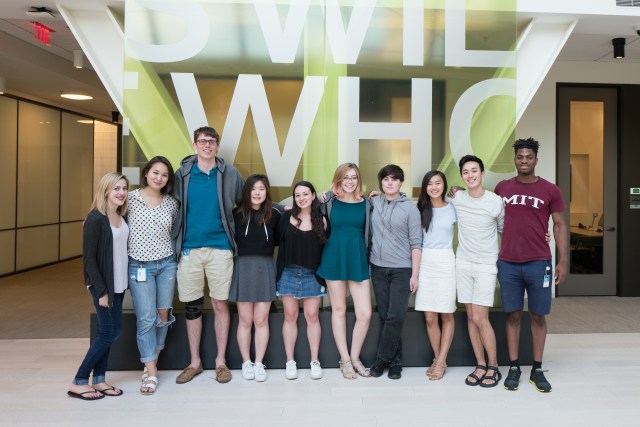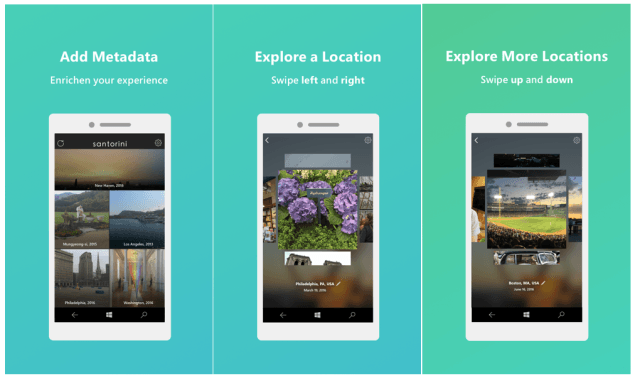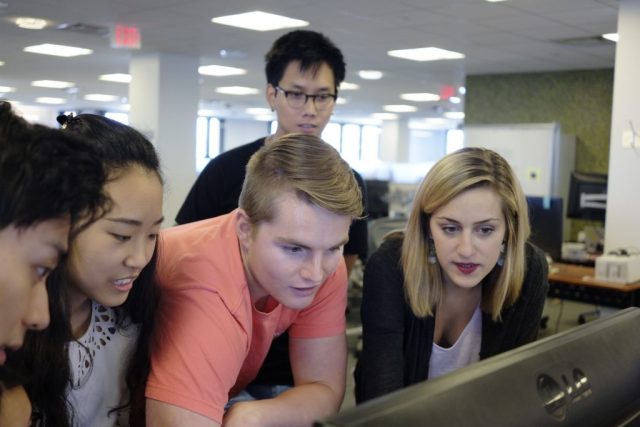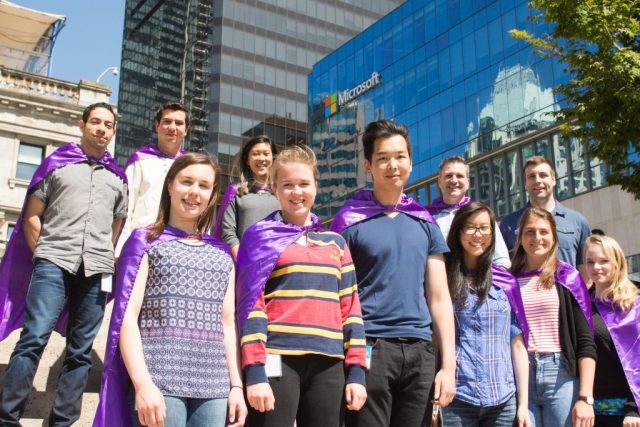
When students with the Microsoft Garage began their internship in Cambridge, Massachusetts in June, they found a new workspace, a pair of managers and an intern who quickly became a guiding force to these newest members of the team – even though she had only started four months earlier.
Maddy Leger, 20, had already completed a 12-week winter internship as a software developer, but was invited to stick around and lead the next round of projects as a program manager – a decision that paid off.
“I’ve been here a little longer, so I was able to help with a lot of the onboarding stuff and kind of guide people through their first couple of weeks at Microsoft,” says Leger, an incoming junior at Northeastern University. She originally planned to do a four-month stint through the university’s co-op program. But in March, after she visited Microsoft’s headquarters in Redmond, Washington, her managers extended her offer through the end of the summer. She officially transitioned into the PM role in the end of April.
“I think part of being a PM is periodically checking in on the devs and designers and making sure they’re in good spirits and doing well,” Leger says. “As a PM, I learned about the importance of beta programs, how to start one and use it to collect telemetry and data from users, and how to use that data to make informed decisions about the features and the product. I’ve also learned a lot about time management. I am currently studying the legal/privacy/security/accessibility review process and why all of those are really important to Microsoft. I’m also hoping to see three of the products ship at the end of this internship, which would be really, really cool.”
One of them is Project Santorini, a Windows app that provides a new way to go through your old photos using metadata. For instance, you can use the app to swipe through photos either using location or time as one naturally does in a photo album.

Leger’s experience is the norm in this program, which is all about tangible results. At the end of their 12- or 16-week internship, interns are likely to see products they’ve worked on released to the public. Not a bad way to begin the new school year and answer the question, “How’d you spend your summer?”
The internship program focuses on a symbiotic relationship between students and mentors.
When they begin their internships, the students break off into teams to tackle the project ideas that excite them the most, and over the course of the internship they work closely with the sponsoring business group, which provides mentorship, guidance and domain expertise to the students. In return, the sponsoring teams benefit from the energies of young, passionate engineers who can deliver on experiments in only a few months.
“It was amazing to see how the team took the project from inception, all the way to the product it is now,” says Mike Tholfsen, one of the product group sponsors for Write Ideas, a new inclusive mobile app that will help people with learning differences more easily convey their ideas from conception to outline. “They have been extremely customer focused and collaborative, and they brought many emerging technologies together while at the same time, taking the idea far beyond what we had initially imagined.”
The apps and updates Leger and the other interns work on are released through The Garage, the outlet for Microsoft teams around the world to get experimental apps and projects out to the public. Before the interns return to school, they are shipping multiple projects as limited “invite-only” releases to get early feedback before the projects are handed to their sponsors to continue the experiment. Project Santorini, Write Ideas, Hearing AI and two browser add-ins (projects Copenhagen and Oceana) are ready – you can check them out and apply to be an early adopter at the Microsoft Garage.

In this internship, everyone does a little bit of everything. Software engineers are heavily involved in the design decisions, user research and sprint planning. Designers lead a lot of the user research and work on multiple projects, and some of them write code for the projects. The PMs, rather than having one feature that they write a spec for, are part of all the teams and help with everything from feature design to legal reviews.
“For students, I think the program demonstrates in a very tangible way that Microsoft is a place where they can have true impact on people’s lives. We have a motto in the Garage: ‘Doers, not talkers,’ and I think we live that motto – students get a chance to deliver working code to real people,” says Ben Fersenheim, who runs The Garage Internship Program in Cambridge, along with George Matthews. “In a way, the hope is that we can use the program as a way to drive change in our engineering culture that will help us ultimately be more agile and successful as a company. And of course there’s the obvious benefit to recruiting. This is a great way to get students excited about opportunities at Microsoft by giving them a deep introduction to our technology, our products and our people.”
The program includes undergrad and graduate students from more than 20 different universities in the U.S. and Canada. They come from computer science programs, engineering programs, design programs – even fine arts programs. Some students come in with previous internships under their belt, while for some this is their first experience with professional software development.
Leger began her internship as a software engineer, but she had very little experience in that field. Her high school had no computer science or engineering classes, and almost all of her college courses so far have been hardware-based or low-level coding (C, C++). At school she does research in GPU computing at the Computer Architecture lab (NUCAR – ece.neu.edu/groups/nucar). “I studied a lot for my interview, did all of my interview questions in C++, and started at Microsoft a couple months later working on a project in Javascript, which I had never coded in before!” she says. “I learned a lot really fast, and my managers were really supportive and answered the million questions I asked every day.” Leger worked with six teams, each composed of six developers, one or two designers and another PM intern to help out with six projects.
“Coming out of this internship, I have a really solid understanding of the entire product lifecycle, from the perspective of all three roles,” she says. “As a software engineer, I learned a new language, created an entire working product from an idea, and learned software engineering principles like code reviews, sprint planning, version control, etc. in 16 weeks. Beyond the software skills, I learned a lot about how to pitch/demo a product, how to use customer research to make informed decisions about features and a whole lot of other soft skills.”

In Vancouver, Canada, Stephane Morichère-Matte has been the senior program manager for the Garage Internship Vancouver Program since April 2014. He oversees the program, coordinating with University Recruiting to hire 50 interns a year from Canadian universities and source out projects from Microsoft’s internal business groups to pitch to interns once they’re on site.
“We are training tomorrow’s leaders,” Morichère-Matte says. “There is no roadmap for what the interns are faced with; these are all real problems and they face the same setbacks that real production teams would face. They improve their tech and design skillsets, and we encourage them to embrace the lean startup model and reach out to their customers as soon as possible.”
“The most challenging part of the internship was deciding on our vision and scoping our project to the time that we had,” says Anastasiya Tarnouskaya, a software developer intern based in Vancouver. “We had a lot of ideas for how to make it amazing, but at the end of the day we had to choose a subset of features to implement based on how valuable they would be to the students using our app.”
Four projects have debuted in the Windows Store as a result of Vancouver’s program. Intern-built projects have also won internal awards, as well as being introduced at Microsoft’s Build conference earlier this year in San Francisco.
“Having [CEO] Satya [Nadella] introduce Seeing AI at Build 2016 was a stand-out moment that exemplified how interns can make a real impact,” he says.
Sign up to try Write Ideas, Hearing AI, Project Santorini and more at The Garage.







